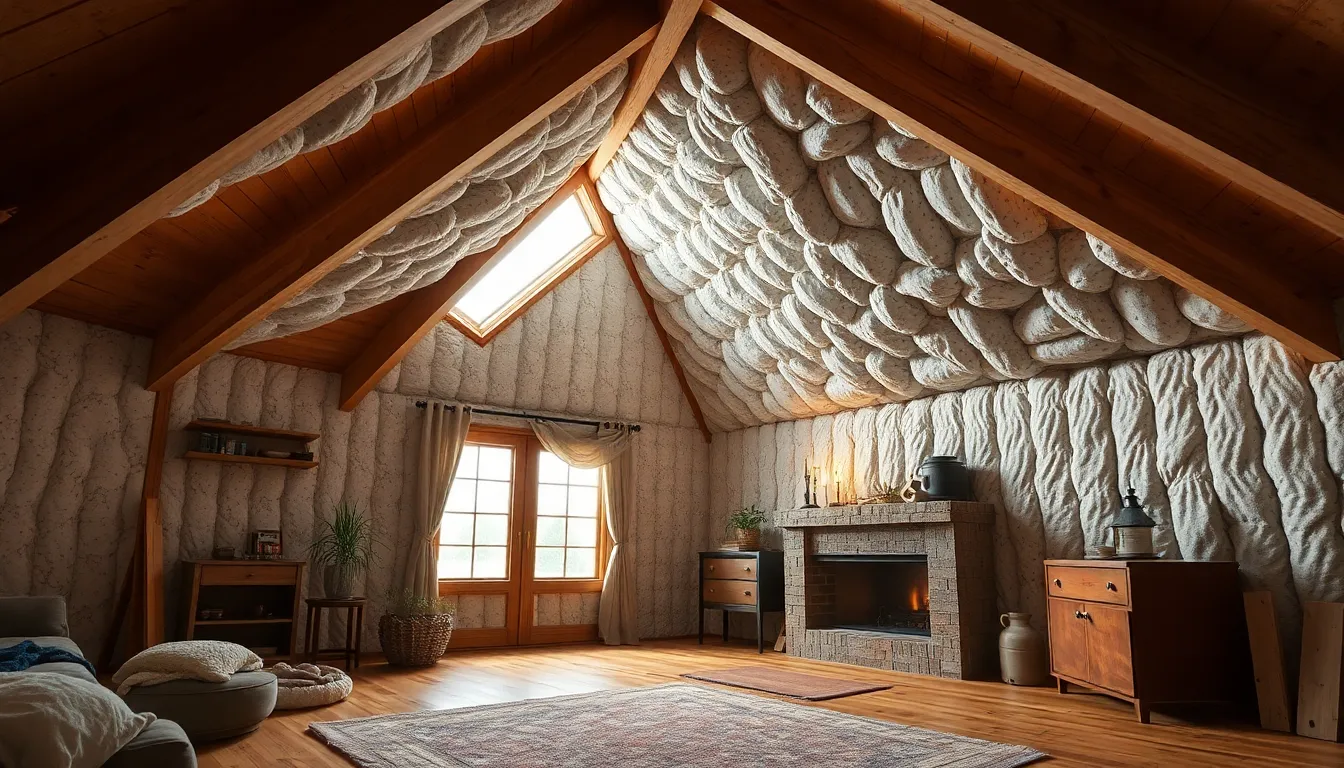When it comes to keeping pests out of your home, insulation might not be the first thing that pops into your mind. But imagine this: a cozy blanket that not only keeps you warm but also gives those pesky critters the boot. That’s right! Pest control insulation is the unsung hero of home protection, combining comfort with a fierce defense against unwanted invaders.
Picture this scenario: you’re settling in for a movie night, popcorn in hand, when suddenly a mouse decides to join the party. Not on your watch! With the right insulation, you can create a fortress that keeps pests at bay while ensuring your home remains snug and energy-efficient. It’s time to take a stand against those uninvited guests and discover how pest control insulation can transform your living space into a pest-free paradise.
Table of Contents
ToggleOverview of Pest Control Insulation
Pest control insulation serves multiple purposes, including acting as a barrier against unwanted pests while improving energy efficiency. This type of insulation incorporates materials designed to deter rodents, insects, and other critters from entering a home. Installation of pest control insulation takes place in critical areas such as attics, crawl spaces, and walls, making these spaces less inviting for pests.
Materials used in pest control insulation often contain attributes that repel common household pests. Using insulation treated with pest-repellent additives offers homeowners a dual benefit: enhanced warmth and decreased pest incursions. Furthermore, the installation of pest control insulation can reduce overall pest populations, leading to less reliance on chemical pest control methods.
Energy conservation plays a crucial role in pest control insulation. It establishes a thermal barrier that minimizes heat loss during colder months and keeps homes cooler in warmer months. The combination of pest deterrence and energy efficiency creates a healthier living environment.
Installation costs vary based on the type of insulation chosen and the size of the area treated. Homeowners can expect to see a return on investment through energy savings and reduced pest control expenses. Investing in pest control insulation contributes to a sustainable and pest-free home environment.
By incorporating pest control insulation, homeowners gain peace of mind. This proactive measure not only protects against pests but also fosters a more comfortable living space. Enhanced comfort and reduced pest activity form a strong case for considering pest control insulation as an integral part of home maintenance.
Benefits of Pest Control Insulation

Pest control insulation offers several advantages for homeowners seeking comfort and protection. This specialized insulation does more than just trap heat or cool air; it actively contributes to pest management and energy savings.
Energy Efficiency
Energy efficiency ranks high among the benefits of pest control insulation. It effectively minimizes heat loss during winter and retains cool air in summer, leading to reduced energy bills. Insulation materials often include pest-repellent properties, enhancing their thermal performance. Optimal insulation reduces the workload on heating and cooling systems, which further lessens energy consumption. As homes maintain consistent temperatures, occupants enjoy a more comfortable environment. Studies indicate that proper insulation can save homeowners up to 15% on annual energy costs.
Pest Deterrence
Pest deterrence is a key feature of pest control insulation. Specialized materials contain additives that repel rodents and insects, making attics and crawl spaces less appealing. Effective insulation not only blocks pathways for pests but also prevents nests from forming in critical areas. Utilizing pest-repellent insulation reduces the reliance on chemical pesticides, supporting a healthier home environment. Research shows that homes with pest control insulation experience significantly lower pest populations compared to those without. These resilient materials create an effective barrier, allowing homeowners to enjoy a pest-free living space with peace of mind.
Types of Pest Control Insulation
Pest control insulation comes in various forms, each offering unique benefits in deterring pests while enhancing energy efficiency.
Spray Foam Insulation
One effective option is spray foam insulation. This insulation expands on application, filling gaps and crevices that pests often exploit. The closed-cell structure of spray foam creates a robust barrier against rodents and insects. It also boasts superior thermal resistance, minimizing heat loss and maintaining a comfortable indoor climate. A notable feature is its pest-repellent additives, which further deter unwanted critters. Studies reveal that homes using spray foam insulation report lower instances of pest infestations compared to traditional types.
Fiberglass Insulation
Another common type is fiberglass insulation. Known for its versatility, fiberglass insulation comes in batts or loose-fill forms. It resists moisture, reducing the chances of mold and mildew while deterring pests. Some fiberglass insulation products incorporate pest-repellent solutions, making it less appealing for critters. Additionally, fiberglass effectively regulates home temperatures, cutting energy costs significantly. Research highlights that homes equipped with fiberglass insulation experience better overall pest management, further validating its dual role in energy efficiency and pest control.
Installation Process
The installation of pest control insulation requires careful planning and execution. Homeowners must ensure that the areas targeted for insulation receive proper treatment.
Preparation Steps
Assessing the space is vital. Measuring the area intended for insulation helps determine the type and quantity required. Cleaning the targeted zones, such as attics or crawl spaces, removes debris and existing insulation. Sealing gaps and cracks beforehand prevents pest entry during and after installation. Setting up protective gear, including gloves and masks, ensures safety throughout the process.
Professional vs. DIY Installation
Hiring professionals guarantees expertise and efficiency. Trained experts possess the necessary equipment and knowledge to manage various insulation materials effectively. DIY installation offers cost savings, but it requires adequate understanding of the materials and techniques involved. Homeowners opting for DIY should be mindful of local building codes and potential health risks. Professional services often come with warranties, adding long-term benefits and peace of mind. Each option—professional or DIY—has distinct advantages that cater to different preferences and budgets.
Cost Considerations
Investment in pest control insulation varies based on multiple factors like material type, installation method, and home size. For instance, spray foam insulation often costs between $0.50 and $2.00 per square foot, while fiberglass options might range from $0.20 to $1.50 per square foot. Each type offers distinct benefits, making understanding their costs essential for homeowners.
Installation type influences price significantly. Professional installation typically incurs higher costs due to labor and expertise. However, DIY installation reduces overall expenses, although it demands proper knowledge of materials and techniques. Homeowners who choose this route often save 20% to 50% on labor costs.
Upfront costs may raise concerns, yet long-term benefits balance this investment. Studies indicate proper insulation can lead to annual energy savings of up to 15%. Lower energy bills over time often compensate for initial expenses, encouraging many to consider pest control insulation as a valuable home improvement.
Monthly pest control fees also diminish with effective insulation. Many homeowners experience reduced pest populations, resulting in fewer chemical treatments needed. Research shows properties with pest control insulation face significantly lower pest activity compared to those lacking this feature.
Overall, while the upfront costs of pest control insulation may seem considerable, the long-term financial benefits and enhanced comfort make it a sound choice for property owners committed to maintaining a pest-free environment. Engaging with both costs and savings helps homeowners make informed decisions about pest control insulation.
Investing in pest control insulation offers homeowners a practical solution for creating a comfortable and secure living environment. By acting as a barrier against unwanted pests while enhancing energy efficiency, this insulation type serves dual purposes that benefit both the home and its inhabitants.
With options like spray foam and fiberglass insulation, homeowners can choose materials that best suit their needs and budgets. The long-term savings on energy costs and reduced reliance on chemical pest control methods make pest control insulation a wise choice.
Ultimately, prioritizing this investment not only fosters a healthier living space but also provides peace of mind against pest infestations. Embracing pest control insulation is a proactive step towards a more efficient and pest-free home.




